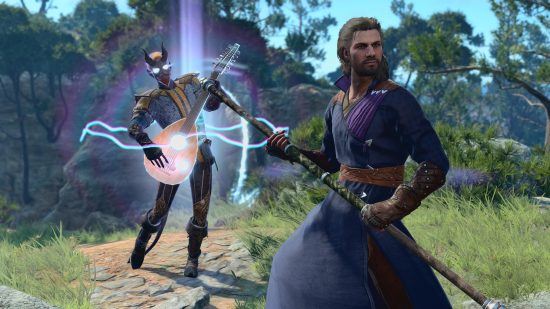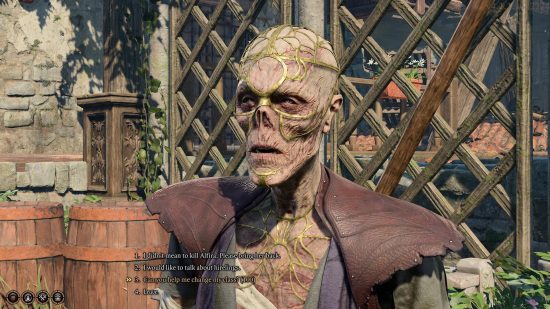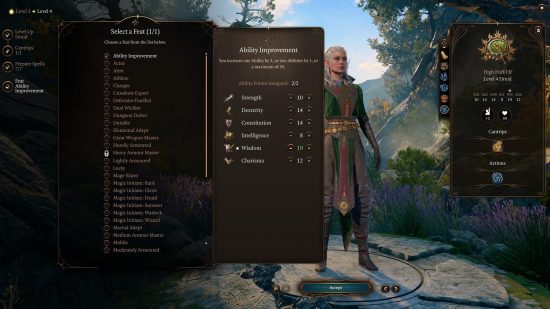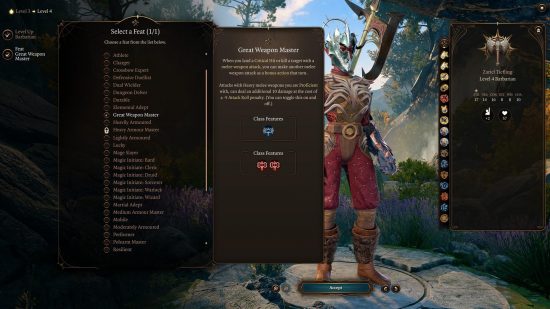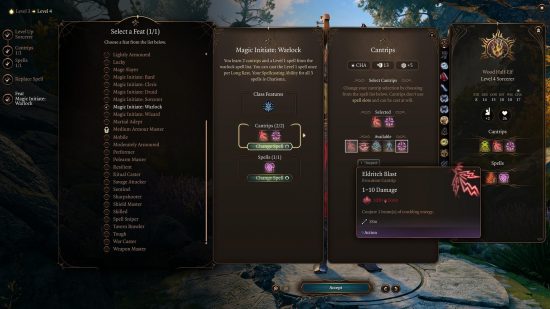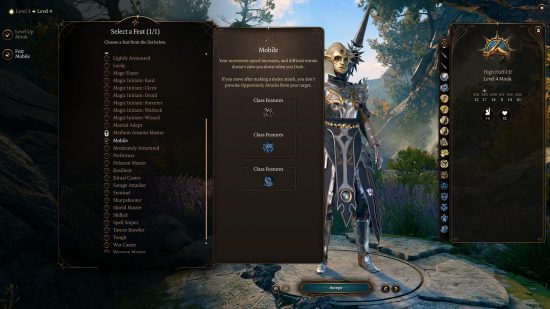Want to unlock the best Baldur’s Gate 3 feats? There are over 40 of these perks in the game, each offering a particular boost to your character’s capabilities. However, since you can only choose a limited number for each party member, it’s always a good idea to consider which will be most useful for your playthrough. Our Baldur’s Gate 3 best feats guide discusses all the perks that you’ll see, as well as tips on choosing optimal feats for each character.
Baldur’s Gate 3 is available now on PC. In our BG3 review, we argue that it’s the best DnD game ever made, and that’s partly due to all the tabletop RPG style options that allow you to fine-tune your squad. The feats mechanic – adapted from the DnD 5e feats system – is a key ingredient in that delicious mix, and something to look forward to during combat and exploration.
If you’re just starting in Larian’s supermassive Dungeons and Dragons RPG, make sure you also check out our guides to the Baldur’s Gate 3 classes, all the Baldur’s Gate 3 races, and Baldur’s Gate 3 companions too. You might also fancy checking out our guides to the BG3 max level, and our tips for playing Baldur’s Gate 3 coop. For now, though, let’s meet…
The best feats in Baldur’s Gate 3
The Baldur’s Gate 3 best feats can be narrowed down to three options that are great for most characters. These are:
However, there are also other options that need not be prioritized, though they offer benefits once you’ve obtained the top-tier selections. Our Baldur’s Gate 3 best feats guide lists down all the perks in the game, as well as their descriptions. Later, we outline why certain perks became our ideal choices.
Baldur’s Gate 3 feats and when you earn them
You can choose to learn feats in Baldur’s Gate 3 once you reach levels 4, 8, and 12. If you plan on multiclassing, do take note that feat unlocks are class-dependent. As such, if you have a level 3 Cleric and you multiclass with a Paladin once you have enough XP, that will only count as a level 1 Paladin rank.
Moreover, abilities are capped at 20 points. As such, feats that grant extra points to a particular stat can only be increased up to that value. Likewise, if you feel that you’ve made a mistake when selecting a feat, you can talk to Withers, the hooded skeleton, to reset your class.
In any case, below are the feats that you can learn in the game:
- Ability Improvement — Gives you two points to allocate to any ability, up to a maximum of 20 for that stat.
- Actor — +1 Charisma; doubles your proficiency bonus for Deception and Performance checks.
- Alert — +5 bonus to Initiative; you can’t be surprised by enemies.
- Athlete — +1 to Strength or Dexterity; standing up when you’re prone uses less movement; +50% jump distance.
- Charger — Gain Charger: Weapon Attack and Charger: Shove. These actions allow you to rush enemies to hit them with your weapon or shove them, respectively.
- Crossbow Expert — Crossbow attacks within melee range no longer have a disadvantage to attack rolls; Piercing Shot also inflicts Gaping Wounds for twice as long.
- Defensive Duelist — When attacked while wielding a Finesse Weapon you’re proficient in, you can use a reaction to add a proficiency bonus to your armor class (AC), possibly causing the attack to miss.
- Dual Wielder — Allows you to use two-weapon fighting even if your weapons aren’t light; +1 AC while wielding a melee weapon in each hand; you cannot dual-wield heavy weapons.
- Dungeon Delver — Gain advantage on Perception checks made to detect hidden objects, and on saving throws made to avoid traps; gain resistance to the damage dealt by traps.
- Durable — +1 Constitution; regain all your HP whenever you do a short rest.
- Elemental Adept — Spells ignore resistance to a damage type of your choice, and they cannot roll a 1. The options include acid, cold, fire, lightning, and thunder damage.
- Great Weapon Master — Landing a critical hit or killing a target with a melee weapon allows you to do another melee weapon attack as a bonus action during that turn. Attacks with heavy weapons that you’re proficient with deal +10 damage at the cost of -5 to their attack roll.
- Heavily Armored — +1 Strength; gain proficiency with heavy armor; requires proficiency with medium armor.
- Heavy Armor Master — +1 Strength; incoming damage from non-magical attacks is decreased by 3 while you’re wearing heavy armor; requires proficiency with heavy armor.
- Lightly Armored — +1 Strength or Dexterity; gain proficiency with light armor.
- Lucky — Gain 3 Luck Points, which can be used to gain an advantage on attack rolls, ability checks, saving throws, and to make an enemy reroll their own attack rolls.
- Mage Slayer — When an enemy casts a spell within melee range of you, you have an advantage on saving throws; allows you to use a reaction to immediately attack the caster; enemies you hit also have a disadvantage on concentration saving throws.
- Magic Initiate: Bard — Learn two cantrips and a level 1 spell from the Bard’s spell list. You can cast the spell once per long rest. Charisma is used as the spellcasting ability.
- Magic Initiate: Cleric — Learn two cantrips and a level 1 spell from the Cleric’s spell list. You can cast the spell once per long rest. Wisdom is used as the spellcasting ability.
- Magic Initiate: Druid — Learn two cantrips and a level 1 spell from the Druid’s spell list. You can cast the spell once per long rest. Wisdom is used as the spellcasting ability.
- Magic Initiate: Sorcerer — Learn two cantrips and a level 1 spell from the Sorcerer’s spell list. You can cast the spell once per long rest. Charisma is used as the spellcasting ability.
- Magic Initiate: Warlock — Learn two cantrips and a level 1 spell from the Warlock’s spell list. You can cast the spell once per long rest. Charisma is used as the spellcasting ability.
- Magic Initiate: Wizard — Learn two cantrips and a level 1 spell from the Wizard’s spell list. You can cast the spell once per long rest. Charisma is used as the spellcasting ability.
- Martial Adept — Learn two maneuvers from the Battle Master subclass and gain a Superiority Die to fuel them. Regain expended Superiority Dice after short and long rests.
- Medium Armor Master — Wearing medium armor does not impose a disadvantage on Stealth checks; the bonus for your AC gained from your Dexterity becomes +3 instead of +2.
- Mobile — Increases your movement speed by three meters; difficult terrain doesn’t slow you down when you dash; moving after a melee attack does not provoke an opportunity attack from nearby targets.
- Moderately Armored — +1 Strength or Dexterity; gain proficiency with medium armor.
- Performer — +1 Charisma; gain musical instrument proficiency.
- Polearm Master — You can use a bonus action to attack with the butt of a glaive, halberd, quarterstaff, or spear.
- Resilient — +1 to any ability; gain proficiency in that ability’s saving throws.
- Ritual Caster — Gain two Ritual Spells of your choosing. Examples include Speak with Dead and Speak with Animals.
- Savage Attacker — When making weapon attacks, you roll your damage dice twice, and you use the higher value.
- Sentinel — When an enemy in melee range attacks an ally, you can use a reaction to attack that enemy. Gain advantage on opportunity attacks, and hitting a creature with such prevents them from moving during that turn.
- Sharpshooter — Ranged weapon attacks do not receive penalties from high ground rules; ranged weapons you’re proficient in deal +10 damage, but have a -5 penalty to their attack roll.
- Shieldmaster — +2 bonus to Dexterity saving throws while wielding a shield. If a spell forces you to make a Dexterity saving throw, you can use a reaction. A failed saving throw halves the damage, and a successful one completely nullifies it.
- Skilled — Gain proficiencies in three skills of your choosing.
- Spell Sniper — Learn a cantrip; the number you need to roll a critical hit is reduced by 1; this effect can stack.
- Tavern Brawler — When you make an unarmed attack, use an improvised weapon, or do a throw, your Strength modifier is added twice to the damage and attack rolls.
- Tough — +2 max HP for every level that you’ve gained.
- War Caster — Gain advantage on saving throws used to maintain your concentration on a spell. You can use a reaction to cast Shocking Grasp at an enemy moving out of melee range.
- Weapon Master — +1 Strength or Dexterity; gain proficiency in four weapons of your choosing.
Best overall feat – Ability Improvement
We feel that among the Baldur’s Gate 3 best feats, none can compare to Ability Improvement. That’s because you gain two points that can be allocated to your class’ preferred DnD stat. Considering that character creation only lets you reach up to 17 in a particular stat, having a +2 bonus is amazing. Moreover, there are certain items, such as the reward for beating Auntie Ethel in the Putrid Bog, that give you an extra point.
Once you’ve reached 20 Strength, Dexterity, Wisdom, or whatever might be the preferred ability of your class, you’ll reap the benefits. This leads to improved damage, more successful rolls, and increased bonuses for the relevant skill checks.
Featured image: baldurs-gate-3-best-feats-guide-2Alt text: Jaheira is given two points to her Wisdom stat, which is ideal for Druids.
Best feat for two-hander-wielding DPS – Great Weapon Master
Great Weapon Master is one of the best feats in Baldur’s Gate 3. It’s actually what turns classes like the Barbarian, Fighter, and Paladin into absolute powerhouses that can take out multiple targets with ease.
While the -5 penalty to attack rolls can be detrimental, there are still buffs from Clerics, Bards, and the like, as well as passives, that can offset this problem.What’s more important is that you gain a +10 bonus to your damage. Moreover, critical hits and killing blows let you do another attack as a bonus action. When combined with other perks, such as the Barbarian’s Frenzy and Reckless Attack, the Paladin’s Divine Smite, or the extra attack class features, you’re looking at killing machines that dominate the battlefield.
Best feat for Charisma-based casters – Magic Initiate: Warlock
Among spellcaster perks, few can compare to Magic Initiate: Warlock. That’s because the Eldritch Blast cantrip and the Hex spell. The former deals decent damage and, since it’s a cantrip, it can be used over and over without expending a spell slot. The force-type element also means that fewer enemies have resistances against it.
As for Hex, this can only do low necrotic damage, but you can give a target a disadvantage on an ability of your choosing. Moreover, killing a target afflicted by Hex allows you to recast it without expending a spell slot. As such, you’ll often debuff your foes in combat.
The key issue here is that Charisma is the spellcasting ability used by both these spells. This makes the perk more viable for a Sorcerer or a Bard, as they also have Charisma as their preferred stat.
Other viable feat options
There are still other perks that you can choose later in the game. For instance, let’s say you’re already level 8 or 12. You’ve already acquired Ability Improvement, but you’re not getting Great Weapon Fighting or Magic Initiate: Warlock due to your class mechanics. Here are our suggestions:
- Mobile — Having bonus movement range is great, and not triggering opportunity attacks tends to be a lifesaver in certain situations. There might be times when you’ve already hit an enemy, even though your main target is further away.
- Sharpshooter — This is the ranged DPS variant of Great Weapon Master. The downside here is that melee classes tend to have more boons/features to make the most out of close-quarters combat.
- Elemental Adept — You can negate enemy resistances to certain elements, such as fire if you like casting Fireball and Scorching Ray.
- War Caster — This is decent for Clerics and other classes that often need to maintain their concentration to make spells last longer (i.e., Shield of Faith and Spirit Guardians).
In any case, these are what we consider as the best feats in Baldur’s Gate 3. With numerous options, you’re bound to fine-tune your characters to suit your playstyle.
For more tips and guidance through this gigantic Forgotten Realms DnD game, check out our guide to BG3 romances, or get to know specific companions better with our detailed BG3 Halsin and BG3 Astarion guides.
